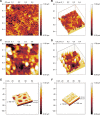Nanoporous solid-state membranes modified with multi-wall carbon nanotubes with anti-biofouling property
- PMID: 30880972
- PMCID: PMC6407906
- DOI: 10.2147/IJN.S189728
Nanoporous solid-state membranes modified with multi-wall carbon nanotubes with anti-biofouling property
Abstract
Purpose: Nanoporous membranes have been employing more than before in applications such as biomedical due to nanometer hexagonal pores array. Biofouling is one of the important problems in these applications that used nanoporous membranes and are in close contact with microorganisms. Surface modification of the membrane is one way to prevent biofilm formation; therefore, the membrane made in this work is modified with carbon nanotubes.
Methods: In this work, nanoporous solid-state membrane (NSSM) was made by a two-step anodization method, and then modified with carbon nanotubes (NSSM-multi-wall carbon nanotubes [MWCNT]) by a simple chemical reaction. Techniques such as atomic force microscopy (AFM), energy dispersive X-ray (EDAX), field emission scanning electron microscopy (FESEM), Fourier-transform infrared spectroscopy (FTIR), contact angle (CA), surface free energy (SFE), protein adsorption, flow cytometry, and MTT assay were used for membrane characterization.
Results: The BSA protein adsorption capacity reduced from 992.54 to 97.24 (μg mL-1 cm-2) after modification. The findings of flow cytometry and MTT assay confirmed that the number of dead bacteria was higher on the NSSM-MWCNT surface than that of control. Adsorption models of Freundlich and Langmuir and kinetics models were studied to understand the governing mechanism by which bacteria migrate to the membrane surface.
Conclusion: The cell viability of absorbed bacteria on the NSSM-MWCNT was disrupted in direct physical contact with carbon nanotubes. Then, the dead bacteria were desorbed from the surface of the hydrophilic membrane. The results of this research showed that NSSM-MWCNT containing carbon nanotubes have significant antimicrobial and self-cleaning property that can be used in many biomedical devices without facing the eminent problem of biofouling.
Keywords: alumina anodic membrane; anodizing; anti-biofilm; antibacterial.
Conflict of interest statement
Disclosure The authors report no conflicts of interest in this work.
Figures












Similar articles
-
Culture of dental pulp stem cells on nanoporous alumina substrates modified by carbon nanotubes.Int J Nanomedicine. 2019 Mar 14;14:1907-1918. doi: 10.2147/IJN.S189730. eCollection 2019. Int J Nanomedicine. 2019. PMID: 30936693 Free PMC article.
-
Zwitterionic polymer brushes via dopamine-initiated ATRP from PET sheets for improving hemocompatible and antifouling properties.Colloids Surf B Biointerfaces. 2016 Sep 1;145:275-284. doi: 10.1016/j.colsurfb.2016.05.010. Epub 2016 May 9. Colloids Surf B Biointerfaces. 2016. PMID: 27208441
-
Fabrication of tethered carbon nanotubes in cellulose acetate/polyethylene glycol-400 composite membranes for reverse osmosis.Carbohydr Polym. 2015 Nov 5;132:589-97. doi: 10.1016/j.carbpol.2015.06.035. Epub 2015 Jul 2. Carbohydr Polym. 2015. PMID: 26256386
-
Toward Sustainable Tackling of Biofouling Implications and Improved Performance of TFC FO Membranes Modified by Ag-MOF Nanorods.ACS Appl Mater Interfaces. 2020 Aug 26;12(34):38285-38298. doi: 10.1021/acsami.0c13029. Epub 2020 Aug 12. ACS Appl Mater Interfaces. 2020. PMID: 32846472
-
Do biological-based strategies hold promise to biofouling control in MBRs?Water Res. 2013 Oct 1;47(15):5447-63. doi: 10.1016/j.watres.2013.06.033. Epub 2013 Jun 27. Water Res. 2013. PMID: 23863390 Review.
Cited by
-
Functionalization of Multi-Walled Carbon Nanotubes Changes Their Antibiofilm and Probiofilm Effects on Environmental Bacteria.Microorganisms. 2022 Aug 11;10(8):1627. doi: 10.3390/microorganisms10081627. Microorganisms. 2022. PMID: 36014045 Free PMC article.
-
Antimicrobial and anti-adhesive properties of carbon nanotube-based surfaces for medical applications: a systematic review.iScience. 2020 Dec 29;24(1):102001. doi: 10.1016/j.isci.2020.102001. eCollection 2021 Jan 22. iScience. 2020. PMID: 33490909 Free PMC article. Review.
-
Facile Synthesis of chitosan-g-PVP/f-MWCNTs for application in Cu(II) ions removal and for bacterial growth inhibition in aqueous solutions.Sci Rep. 2022 Oct 17;12(1):17354. doi: 10.1038/s41598-022-22332-8. Sci Rep. 2022. PMID: 36253438 Free PMC article.
-
Anti-Infective and Toxicity Properties of Carbon Based Materials: Graphene and Functionalized Carbon Nanotubes.Microorganisms. 2022 Dec 9;10(12):2439. doi: 10.3390/microorganisms10122439. Microorganisms. 2022. PMID: 36557692 Free PMC article. Review.
-
Antibiofilm Effect of Nitric Acid-Functionalized Carbon Nanotube-Based Surfaces against E. coli and S. aureus.Antibiotics (Basel). 2023 Nov 11;12(11):1620. doi: 10.3390/antibiotics12111620. Antibiotics (Basel). 2023. PMID: 37998822 Free PMC article.
References
-
- Lee W, Ji R, Gösele U, Nielsch K. Fast fabrication of long-range ordered porous alumina membranes by hard anodization. Nat Mater. 2006;5(9):741–747. - PubMed
-
- Colombo P. In praise of pores. Science. 2008:381–383. - PubMed
-
- Davis ME. Ordered porous materials for emerging applications. Nature. 2002;417(6891):813–821. - PubMed
-
- Vlassiouk I, Krasnoslobodtsev A, Smirnov S, Germann M. “Direct” Detection and Separation of DNA Using Nanoporous Alumina Filters. Langmuir. 2004;20(23):9913–9915. - PubMed
-
- Vlassiouk I, Takmakov P, Smirnov S. Sensing DNA hybridization via ionic conductance through a nanoporous electrode. Langmuir. 2005;21(11):4776–4778. - PubMed
MeSH terms
Substances
LinkOut - more resources
Full Text Sources
Molecular Biology Databases
Miscellaneous

